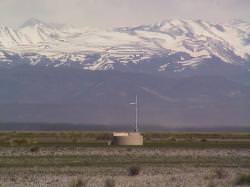You know that big list of unsolved mysteries in astronomy? Well, you can remove, “what causes the highest energy cosmic rays?” Thanks to new research using the Pierre Auger Cosmic Ray Observatory in South America, the answer appears to be: supermassive black holes.
High energy cosmic rays are actually particles – protons mostly – accelerated to tremendous velocities. When they crash into the Earth’s atmosphere, they explode in a spray of energy and sub-particles that can be detected here on the surface. Fortunately our atmosphere protects us from damage, but out in space, they’re a real threat.
Just a single particle can have the same energy as fast moving tennis ball.
Astronomers have been wondering for years how particles can get boosted to such high energy levels. A massive team of 370 researchers from 17 countries have been working on the answer using the newly developed Pierre Auger Cosmic Ray Observatory, nestled in the mountains of South America.
The observatory is actually an array of detectors spread out over a 3,000 km2 area. As the cosmic rays collide with the atmosphere, the resulting spray of particles are caught by the detectors, which house large tanks of water. The detectors are so sensitive, they can detect a different in timing, which allow astronomers to triangulate the direction the cosmic ray came from. The particles are flung with such energy that they point back to their galaxies, like bullets coming from a gun.
Before the Pierre Auger observatory, cosmic ray detections were rare. Astronomers just didn’t have enough data to know where they were coming from. But over the last 3 years, the observatory has recorded a million cosmic rays, including 80 of the highest energy.
Astronomers now know that cosmic rays don’t come from all regions of the sky, but they’re shot out from actively feeding supermassive black holes.
The exact process that creates the cosmic rays isn’t fully understood, but astronomers think that the environment around an active supermassive black hole is ferocious, to say the least. Powerful magnetic fields are generated, which can act like natural particle accelerators, pushing protons to energy levels much higher than anything physicists could recreate with our technology.
Original Source: University of Chicago News Release


This is really exciting. I am deeply interested in knowing more about Black hole infact am choosing it as my seminar topic for presentation in January as my supervisor as an undergraduate of the University has told me to find a topic.
I will be grateful if I could get a comprehensive write up on this subject as it will be of help to me in the presentation.
Thanks in anticipation.
I`m very much interested in space exploration and universe. I have doubt in this topic. according to the information above cosmic rays are partiles especially protons which are accelerated to high energies. but black hole is a heavenly body similar to star with large gravitational force from which light ray cant able to escape from the force since the escape velocity is very high. please clarify my doubt
thanks in anticipation
I imagine the same beginning of a Big Bang as gstewart. I assume the universe is of infinite size/mass/energy. This is contradicted by the experts. But, if it’s true (unprovable, apparently) then perhaps over enough trillions of years, a super-super-super massive hole might form, with galaxies streaming toward it as is expoldes. Then we have a random condition with stuff going every which way. Maybe explanes the background radiation also. Let’s dream on!